Yielding, early ripening, undemanding to care and ideal for conservation tomato "Gulliver"
Meet: unpretentious and unusually tasty tomato variety called Gulliver! Differs in high adaptation to drought and heat, resistance to many diseases, excellent yield and simple agricultural technology throughout the growing season. Illustrative photos and favorable reviews will leave no doubt about the choice of tomato culture for cultivation at their summer cottage.
The content of the article
Characteristics and description of the variety
The variety was bred by the Russian breeder L.A. Myazina. The variety was registered in the State Register in 2009. Recommended for cultivation in the Central Black Earth Region, but it is successfully bred in all regions. Gulliver's tomato crop is not the only work of a Russian breeder. In total, the State Register contains 25 varieties and 39 hybrids of her authorship.
reference... Lyubov Anatolyevna Myazina has been breeding for over 30 years. Her hybrids are created by hand pollination of two different varieties. This is how the best qualities of the father and mother plants are laid in the genes.
Distinctive features
Determinant bush, height - 1.5-1.7 m, average foliage, medium-sized leaves, simple inflorescences, strong stem. The brush is simple, unbranched, forms 5-6 fruits. Tomatoes are tied in all weather conditions.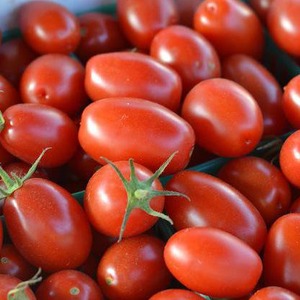
The variety is early maturing, from the moment of planting to full ripening, 100-110 days pass. Recommended for cultivation in open and closed ground, drought-resistant and heat-resistant, not afraid of temperature changes.
Average yield, from 1 sq. m, up to 6 kg of fruits are harvested, provided that 3-4 seedlings are planted per 1 sq. m.
Possesses high resistance to the main diseases of the Solanaceae family, such as late blight, apical and root rot.
It does not need pinching, but it requires a mandatory garter, otherwise the fruitful branches will not withstand the weight of ripe vegetables.
Fruit characteristics
The average weight of tomatoes is 95-115 g, the shape is cylindrical, elongated, reminiscent of a plum. The color is rich red, the flesh is fleshy, practically without liquid. The taste is soft, sweet, with a pleasant sourness. There are 2 seed chambers, few seeds. The rind is thin but firm.
The purpose of ripe vegetables is universal: from fresh consumption to processing for winter harvesting. They preserve flavor perfectly in whole-fruit canning. Tomatoes do not crack during heat treatment, which makes it possible to dry the fruits for the winter in the oven at a low temperature. Also vegetables are dried and frozen.
Tomatoes perfectly retain their appearance during long-term transportation and storage for a month.
In the photo there are Gulliver tomatoes.
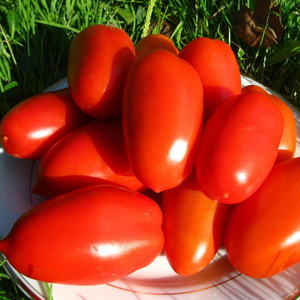
How to grow seedlings
Sowing seeds for seedlings begins 2 months before planting in the ground. Before sowing, the seeds undergo a special treatment to improve germination.
Seed preparation
The planting material is checked for germination by placing the seeds in a saline solution for 10 minutes. Seeds that have floated to the surface are not suitable for planting.
Seeds collected independently are subject to mandatory disinfection before sowing. To do this, they are placed in a weak solution of potassium permanganate for 20 minutes.
reference... Seed material purchased in a specialized store does not need processing. The originator took care of everything himself.
After disinfection, the grains are washed with running water, wrapped in gauze, slightly moistened and left in a warm place for 2-3 days for germination. The room temperature must be at least 23 ° C. After the sprouts appear, the grains are ready for sowing.
reference... Gulliver tomato seeds are produced by the Aelita and Sibirskiy Sad agrofirms.
Capacity and soil
The soil mixture is prepared from garden soil, humus and wood ash. All components are thoroughly mixed and spilled with a hot solution of pink potassium permanganate to destroy the pathogenic flora.
They are planted in separate containers or in a common wooden box, in which holes are first made at the bottom so that when watering there is no stagnation of excess moisture. If you sow seeds directly into peat pots, then picking the seedlings is not necessary in the future. In addition, during transplantation, seedlings are planted in the ground along with peat pots, which dissolve in the soil without harming the root system.
The planting containers are filled with prepared soil by half. In the future, as young bushes grow and develop, the remaining soil is poured into the containers. This gives the seedlings more nutrients.
Sowing
The seeds are sown into grooves 1.5-2 cm deep, making the row spacing of 3 cm. If the seeds are sown shallowly, they will germinate together with the shell, which will slow down their further growth. After sowing, the soil is slightly moistened with a spray bottle and left in a warm and bright room at a temperature of at least 22 ° C. The planting containers are covered with foil or glass to create a greenhouse effect.
Growing and care
After the appearance of the first sprouts, the containers are rearranged to a more illuminated place, for example, on a windowsill.
reference... Avoid direct sunlight. Young sprouts can get severe burns.
Watered as needed with warm, settled water using a shallow watering can along the edge of the nursery. After watering, the soil is shallowly loosened for better oxygenation.
When 2 true leaves appear, the seedlings are dived, seated in separate containers. If the seedlings are left in a common box, the distance between the plants is maintained at least 10 cm. After picking, the seedlings are shaded for 1-2 days, then rearranged in a well-lit place.
2 weeks before planting in open ground, the seedlings begin to harden. This technique strengthens the immunity of seedlings and promotes faster adaptation to outdoor conditions. The hardening process consists in the daily stay of the seedlings in the open air for 25-45 minutes. Gradually, this time is increased to 12 hours, while simultaneously reducing the night temperature in the room where the seedlings are introduced to 13 ° C.
How to grow tomatoes
After 2 months, the seedlings are ready for transplanting into the ground. They are transplanted to open beds in late May - early June, when the threat of night frosts has passed.
Landing
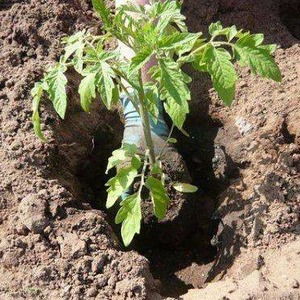
The soil for tomatoes is prepared in the fall. The earth is dug up and organic matter or a complex of mineral fertilizers is applied. Tomatoes grow well in those beds where legumes, onions, cucumbers, and cabbage previously grew.
Planting scheme: 70 cm - distance between seedlings, 40 cm - row spacing.
A little wood ash is introduced into the prepared holes 15 cm deep and watered abundantly. After transplanting, the soil is well compacted, watered again, the beds are loosened and hilled. It is best to transplant in the evening or on a cloudy day - so young bushes are more likely to adapt to new conditions.
reference... For a quick build-up of green mass, 1 teaspoon of ammonium nitrate is placed in each well.
Further care of the Gulliver tomato
As the seedlings adapt to new conditions, they set regular watering... Water abundantly, but not often.In normal weather, 3-4 liters of warm, settled water are poured under each bush, strictly under the root, without falling on the leaves. On dry days, the amount of watering is increased, making sure to control the level of humidity in the beds. Waterlogging of the soil leads to the development of fungal diseases.
After each watering, the soil is loosened, spud and weeds are removed with roots. These simplest methods promote better oxygen penetration to the roots and protect plants from many pests.
To keep the beds moist longer, they mulch... This is especially important on hot days when moisture evaporates faster than usual. In addition, mulch protects the beds from pests moving underground, which are dangerous in that they violate the root system of plants.
Top dressing carry out 3 times for the entire growing season. The first feeding is given during flowering, the second - during the formation of ovaries, and the third time - during the fruiting period. A complex of mineral fertilizers or organic matter is well suited as dressings. As organic matter, infusion of mullein and bird droppings are used in a ratio of 1:15.
Features of cultivation and possible difficulties
Bushes require mandatory garters, otherwise they will begin to break under the weight of the weight of the fruit. For this, wooden stakes or metal rods are installed next to each bush. The bushes are fixed to the support immediately when transplanted into the ground. Due to the timely garter, a strong and even stem is formed. As the fruitful branches grow and develop, they are also fixed to the support.
The plant does not require constant pinching, which greatly simplifies care during the growing season. In the beginning, to improve fruiting, the plant is formed into 2 or 3 stems, removing all unnecessary stepchildren. This technique allows you to get the maximum yield.
Diseases and pests
Tomato Gulliver is not prone to diseases that often affect the nightshade family. But still, some crop rotation rules will further protect the crop from possible infections.
It is not recommended to place tomato beds next to potatoes. This is because the plants belong to the same family and suffer from the same diseases and pests. The plantings are not thickened so that all bushes receive the same amount of light and are regularly ventilated.
In a rainy summer, plants are sprayed with Phytosporin or copper sulfate from late blight. Phytophthora is a fungal disease, high humidity is a prerequisite for its spread.
The most common pests are aphids, whiteflies and Colorado potato beetles. Treatment of the stems with soapy water saves from aphids. All plants with a large accumulation of parasites are sprayed with the same solution. The Colorado potato beetle is harvested by hand along with its larvae.
The larvae are usually found on the inside of the leaves, therefore, when inspecting the plants, you must carefully examine the leaves on both sides. Pheromone traps, which can be purchased in specialized stores, save the whitefly.
reference... Pheromone traps capture only parasites without harming other insects that are not pests.
Also, spraying of plants with broths of sharp-smelling herbs: burdock, calendula, onion husks, onion arrows, garlic serves as prevention. Planting calendula, marigold and mustard next to tomatoes saves the culture from many parasitic insects that do not approach the beds because of the pungent smell of herbs.
The nuances of growing in open ground and in a greenhouse
The tomato is recommended for cultivation in the Central Black Earth Region, but it is successfully grown in all regions, including the northern ones. Tomatoes are planted under film shelters earlier than in open ground, for 2-3 weeks, depending on weather conditions.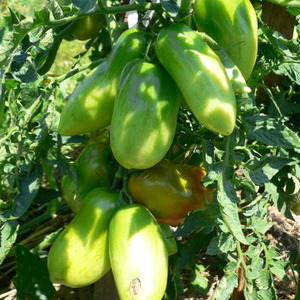
In the greenhouse, during flowering, the bushes are slightly shaken so that the barren flowers crumble and pollination becomes full.As it grows, the bush is formed into 2 stems, and with rare planting, 3 stems are left. The lower leaves must be removed to exclude the development of fungal spores.
Plant height depends on soil fertility and climatic conditions. So, in the Urals or Siberia, the growth does not exceed 60 cm. Consequently, the quantitative indicator will be lower than with full development.
In fertile soil in warm regions, where the culture is bred in the open field, its height reaches 1.7 m.To limit the growth point, pinch the crown of the plant.
In cold regions, the culture is grown only in greenhouses or under a film cover. In closed structures, the risk of developing infections is higher than in open beds. This is due to the constantly elevated temperature and humidity. Therefore, the greenhouse must be regularly ventilated to destroy the pathogenic environment. But do not forget that drafts have a detrimental effect on tomatoes.
Harvesting and application of the crop
Fruit ripening is amicable - this is an important distinguishing feature of Gulliver. It is not necessary to wait for the vegetables to fully ripen; they are able to pick up color on their own at room temperature for several days. Placing unripe tomatoes next to ripe ones will speed up the time of independent ripening.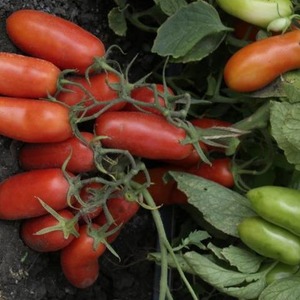
At an air temperature of + 10 ° C and below, vegetables are harvested green. Cold nights promote the development of fungal diseases and rotting of vegetables. In any case, tomatoes in the beds will not be able to ripen at this temperature.
The use in cooking is universal. Ripe vegetables are perfect for fresh salads and other vegetable dishes. Smaller tomatoes are used in whole-fruit canning. They do not lose their taste in pickles and marinades and are perfect for making tomato products: pasta, ketchup, sauces, juices.
An important property of ripe vegetables is that they withstand heat treatment without cracking. Due to this, they are dried in the oven at low temperature or in the sun. Tomatoes are also dried and frozen.
Tomatoes are subject to long-term storage for 4 weeks without loss of appearance and taste. They perfectly withstand long-term transportation.
Advantages and disadvantages
The variety has many advantages:
- survival rate in all regions;
- good adaptation to temperature changes;
- high resistance to diseases;
- fruit ovary in any climatic conditions;
- does not require pinning;
- unpretentious care;
- good productivity;
- early maturation;
- great taste;
- unusual shape;
- versatility in cooking;
- long-term storage;
- long-term transportation;
- the possibility of self-selection of seeds for planting.
The disadvantages of culture can be attributed only to the obligatory garter.
Farmers reviews
Despite the declared limited regions where the species can take root and give a good harvest, trustworthy reviews come from different regions, which indicates the high ability of the tomato to adapt to any weather conditions. The opinions of gardeners who planted this culture:
Nikolay, Yekaterinburg: «The description says that tomato can only be grown in the Central Black Earth Region. I decided to take a chance. Sowed 5 seeds, all sprouted. The seedlings were growing well. After planting in the ground, the bushes quickly adapted. They did not require much attention beyond the usual care. Almost all flowers were set, there were a lot of fruits. I will grow more. "
Violetta, Barnaul: “I grow various vegetables, including tomatoes. I buy Gulliver's seeds. Delicious neat fruits like fresh and canned. I did not observe any diseases during the growing season. "
Conclusion
Gulliver tomatoes are able to surprise with unusual fruits, which have excellent taste. The main value of vegetables is in their unique use in cooking, as soon as imagination dictates.
The crop itself during the growing season is characterized by high adaptation to any weather conditions, the ability to set fruits in any temperature regime, good productivity, immunity to many diseases and simple agricultural technology. These positive aspects suggest that all tomato lovers should definitely try this variety on their plots.